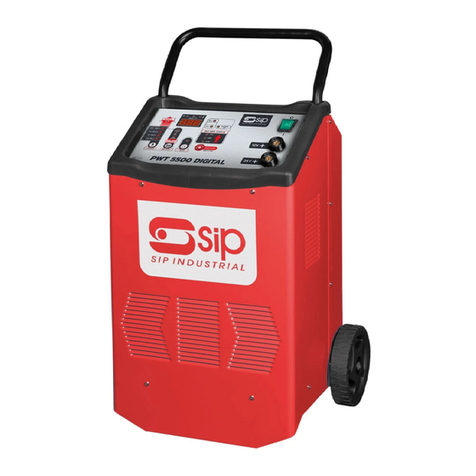16
PARTS LIST - STARTMASTER P440
Ref. No. Description SIP Part No.
1 Handle PW02-00082
2 Cover PW02-00085
3 Chassis PW02-00091
4 Rectifier PW02-00033
5 On/Off switch PW02-00022
6 High/Low switch 16a PW02-00021
7 Front frame (plastic) PW02-00097
8 Ammeter 20A/start PW02-00016
9 Fuse holder PW02-00010
10 Cable gland PW02-00079
11 Fuse 100a PW02-00004
12 Cover for fuse holder PW02-00011
13 Red cable PW02-00056
14 Red/Black clamps PW02-00071
15 Black cable PW02-00064
16 Mains lead PW02-00111
17 Terminal assy complete PW02-00104
18 Front panel PW02-00093
19 Transformer PW02-00047
5
SAFETY INSTRUCTIONS….cont
During charging, batteries give off some hydrogen and oxygen creating a highly ex-
plosive mix. Ensure adequate ventilation exists and avoid sparks, smoking, etc.
During battery maintenance ensure adequate clean water is available in the event of
an acid spill. The liquid inside batteries is highly corrosive therefore ensure that it is not
allowed to make contact with the skin (especially eyes). In the event of contact, flush
the area with clean water and immediately consult a doctor.
Lead-acid batteries store a large amount of energy. Short-circuiting the battery or
charger terminals will cause the battery to try and release this energy immediately,
which can result in fire or personal injury. Prevent any metal object (or other conduc-
tive material) from touching the + and –terminals of the charger or battery at the
same time.
KNOW YOUR STARTER / CHARGER: Read and understand the owner's manual and la-
bels affixed to the charger. Learn its applications and limitations, as well as the poten-
tial hazards specific to it.
DO NOT USE THE STARTER / CHARGER IN DANGEROUS ENVIRONMENTS: Do not use your
Starter / charger in damp or wet locations, or expose it to rain. Always provide ade-
quate space around the starter / charger.
KEEP CHILDREN AND UNTRAINED PERSONNEL AWAY FROM THE WORK AREA: All visitors
should be kept at a safe distance from the work area.
STAY ALERT: Always watch what you are doing and use common sense.
DISCONNECT THE STARTER / CHARGER FROM THE MAINS SUPPLY: When not in use.
DO NOT ABUSE THE MAINS LEAD: Never pull the mains lead it to remove the plug from
the mains socket. Keep the mains lead away from heat, oil and sharp edges. If the
mains lead is damaged, it must be replaced by the manufacturer or its service agent
or a similarly qualified person in order to avoid unwanted hazards.
HAVE YOUR STARTER / CHARGER REPAIRED BY A QUALIFIED PERSON: The starter / charger
is in accordance with the relevant safety requirements. Repairs should only be carried
out by qualified persons using original spare parts, otherwise this may result in consid-
erable danger to the user and void the warranty.
DANGER! Check that the starter / charger is in sound condition and good working
order. Take immediate action to repair or replace damaged parts.
USE RECOMMENDED PARTS ONLY - Unapproved parts may be dangerous and will
invalidate the warranty.
WARNING! Only operate on a level and stable surface.
WARNING! Do not allow untrained persons to operate the charger and do not oper-
ate the machine without all covers etc. correctly fitted.
WARNING! RISK OF ELECTRIC SHOCK. Do not expose the starter / charger to water
spray, rain, dripping water or moisture of any kind.
Do not move or handle the charger when it is running.
Do not leave the charger unattended for long periods when in use. Switch the




























